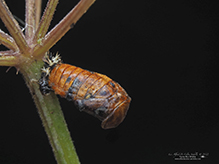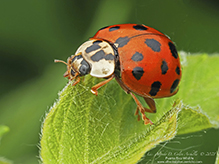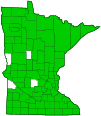lady beetles
(family Coccinellidae)
Overview • Description • Distribution • Taxonomy
Lady beetles are considered beneficial. Three species feed on plants and three species feed on fungi. All other species prey on soft-bodied insects, mostly aphids and scale insects, but also insect eggs, mites, and small larvae. Some species have been used as biological controls of agricultural pests. In the fall, lady beetles seek a warm dry place to hibernate. Many species congregate in large groups. They may shelter under bark, under a log, in leaf litter, or in other protected locations. This often includes crevices in window frames and cool corners of dark rooms. On warm sunny winter days, they may become active. When attacked, lady beetles release a yellowish fluid from their legs containing toxic alkaloids that make them distasteful to predators. |
||
Description |
||
Lady beetle adults are small, 1 ⁄32″ to ⅜″ (1 to 10 mm) in length. They are often bright yellow, red, or orange, with highly contrasting black markings, sometimes black with highly contrasting yellow, red, or orange markings. The bright colors are thought to serve as a warning to predators of their unpalatability. Some species are entirely black. The body is broadly oval to nearly round. When viewed from the side it is strongly convex above and flat below. The exoskeletal plate covering the thorax (pronotum) is wider than long and is distinctly narrowly flattened (margined) or keeled along the sides. The plate between the wing bases (scutellum), is small and triangular. The thick, hardened, shell-like forewings (elytra) completely cover the abdomen. They do not have grooves or rows of pits (punctures). The head is shallowly inserted in the first segment of the thorax and is partly or completely covered by the pronotum. The antennae have 7 to 11 segments and are always short, usually very short. The last 3 to 6 segments are weakly expanded into a club. The legs are short. The last part of each leg (tarsus), corresponding to the foot, has four segments, but the third segment is minute and tucked within the extended lobes of the second segment, making the leg appear to have only three segments. |
||
Distribution |
||||
|
Sources |
|||
| 6/3/2023 | ||||
Taxonomy |
|||
Order |
Coleoptera (Beetles) | ||
Suborder |
Polyphaga (Water, Rove, Scarab, Long-horned, Leaf, and Snout Beetles) | ||
Infraorder |
Cucujiformia | ||
Superfamily |
Coccinelloidea (lady, fungus, scavenger, and bark beetles) | ||
Coccinellidae was formerly included in the superfamily Cucujoidea. That family historically has been taxonomically difficult. A recent large-scale phylogenetic study of Cucujoidea (Robertson et al., 2015) analyzed the DNA from 384 species. As a result of the study, several subfamilies were raised to family level and one new superfamily was created. Coccinelloidea, the new superfamily, contains fifteen families of beetles, including Coccinellidae (lady beetles). |
|||
Subordinate Taxa |
|||
Subfamily Chilocorinae (scale-feeding lady beetles) Subfamily Coccidulinae Subfamily Coccinellinae (common lady beetles) Subfamily Epilachninae (plant-eating lady beetles) Subfamily Exoplectrinae Subfamily Microweiseinae Subfamily Monocoryninae Subfamily Ortaliinae Subfamily Scymninae Subfamily Sticholotidinae |
|||
Synonyms |
|||
|
|||
Common Names |
|||
lady beetles ladybird beetles |
|||
The term lady beetle is more appropriate than ladybug because the word “bug” refers to insects in the order Hemiptera. |
|||
Glossary
Elytra
The hardened or leathery forewings of beetles used to protect the fragile hindwings, which are used for flying. Singular: elytron.
Pronotum
The exoskeletal plate on the upper side of the first segment of the thorax of an insect.
Scutellum
The exoskeletal plate covering the rearward (posterior) part of the middle segment of the thorax in some insects. In Coleoptera, Hemiptera, and Homoptera, the dorsal, often triangular plate behind the pronotum and between the bases of the front wings. In Diptera, the exoskeletal plate between the abdomen and the thorax.
Tarsus
On insects, the last two to five subdivisions of the leg, attached to the tibia; the foot. On spiders, the last segment of the leg. Plural: tarsi.
Visitor Photos |
|||||
Share your photo of this insect. |
|||||
| This button not working for you? Simply email us at info@MinnesotaSeasons.com. Attach one or more photos and, if you like, a caption. |
|||||
Alfredo Colon |
|||||
 |
|||||
MinnesotaSeasons.com Photos |
|||||
|
|||||

Slideshows |
||

Visitor Videos |
|||
Share your video of this insect. |
|||
| This button not working for you? Simply email us at info@MinnesotaSeasons.com. Attach a video, a YouTube link, or a cloud storage link. |
|||
Other Videos |
|||
| Coccinellidae | Ladybugs | insect histrology insects historology |
|||
About
Nov 9, 2022 Coccinellidae, also known as ladybugs or ladybirds, are a family of beetles that are known for their brightly colored, domed bodies and black spots. They are found all over the world, and are popular among gardeners and farmers because they are natural predators of aphids and other plant-eating insects. Ladybugs are beneficial insects and are sometimes introduced into crops to help control pests. They are also important as bioindicators, meaning that their presence or absence can indicate the health of an ecosystem. There are over 5,000 species of ladybugs, ranging in size from less than 1 millimeter to over 10 millimeters, and they come in a variety of colors and patterns. Ladybugs have a relatively short lifespan, typically living only a few months, but they are able to reproduce quickly, laying hundreds of eggs in a single season. |
|||

Visitor Sightings |
|||||
Report a sighting of this insect. |
|||||
| This button not working for you? Simply email us at info@MinnesotaSeasons.com. Be sure to include a location. |
|||||
| A/C Christian
Church of
Minneapolis 7/22/2023 |
Location: Westwood Hills Nature Center At the Westwood Hills Nature Center, we saw some life on July 22 this year. This was all found by the A/C Christian Church of Minneapolis. |
||||
| Alfredo Colon 8/2/2022 |
Location: Albany, NY |
||||
MinnesotaSeasons.com Sightings |
|||||
|
|||||

Created: 6/3/2023
Last Updated:


